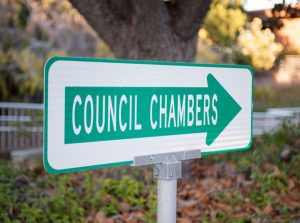It has been more than two years since the Santa Clara City Council first considered an ordinance designed to curb the problems high-density housing created in neighborhoods surrounding Santa Clara University.
The ordinance, called the “Neighborhood Preservation Ordinance,” aimed to remedy the concerns raised by residents living near Santa Clara University, issues such as boisterous parties, cramped parking and excessive trash. These problems arose, they claimed, because the city allowed too many people — students mostly — to live in homes designed for “single families.”
However, the ordinance ran up against opposition.
Scores of students protested the ordinance, claiming it discriminated against them; and, if passed, would result in many students going without homes. A Change.org petition amassed 1,367 digital signatures, galvaning area students. However, councilmember Teresa O’Neill, said the effort to pass the ordinance has since fizzled. “It died a political death. There just wasn’t enough support to move it forward,” she said.
The ordinance kept bouncing back and forth between Council and the Planning Commission, she said. And although Santa Clara City Attorney Ren Nosky previously said such an ordinance could withstand legal scrutiny, the Council couldn’t agree on a direction for the ordinance, O’Neill said.
Instead, the City has been working to tackle the problems raised by those living near mini-dorms, or boarding houses as the City calls them, without creating an ordinance prohibiting them, she said. The city formed a committee, made up of city and university employees, neighborhood association representatives and police, to address every problem stemming from mini-dorms.
Team 200 is a unit of Santa Clara Police Department officers dedicated to addressing problems on campus before they escalate, said Lt. Kurt Clarke.
The unit, which has been around for roughly 10 years, is partially funded by the university. The university has also hired four more campus security guards, who also patrol campus-adjacent neighborhoods, O’Neill said.
Team 200 is rotating group of officers, Clarke said. That way, every officer has a clear idea of what the social climate in the areas on and around campus. The unit deals with noise complaints and aims to “take a proactive approach to underage drinking” and “create positive social behavior,” Clarke said.
For its part, the university has established what it calls neighborhood ambassadors, said Kimberly Gilke-Wall, assistant dean for off-campus student life. Those neighborhood ambassadors are similar to resident advisors in the dorms. The idea is to give the same support to students living off campus as the university provides to students on campus, she said.
In this way, the university can help curb some of the less-than-desirable behavior that gives rise to much of the strife between students living in mini-dorms and their neighbors, she added.
Many critics have said the problems have arisen because of the city’s unwillingness to enforce its laws.
While O’Neill acknowledged code enforcement was an issue when the city only had one code enforcement officer, she said the city has begun contracting with a company to provide additional code enforcement. In an attempt to get away from what she called a “rubber stamp” policy, O’Neill said the committee has also set new guidelines for remodeling in neighborhoods zoned for single-family homes.
“We look for things where a house could be divided into separate living areas,” she said.
Neighbors can now see the plans for a proposed remodel, she added.
Most of the effort, O’Neill said, has focused on stepping up efforts to ensure police and code enforcement are more strict about enforcing guidelines that give rise to boarding houses and the problems created by them.
Rezoning has been also been inconsistent, she said. The city plans to amend its zoning ordinance to allow more predictability and clarity in how it establishes how every property can be used.
“I think we still have a lot more work to do,” she said “There are still some kinks … I am feeling that this could be the time.”











0 comments